
From Nov. 21 through Nov. 26, THN publisher W. Graeme Roustan travelled from one end of Ukraine to within a few kilometers of the eastern front line in the war with Russia and back again to learn what he could about the state of hockey in war-torn Ukraine.
From Nov. 21 through Nov. 26, THN publisher W. Graeme Roustan travelled from one end of Ukraine to within a few kilometers of the eastern front line in the war with Russia and back again to learn what he could about the state of hockey in war-torn Ukraine.

War has been raging in Ukraine since Russia invaded its democratic neighboring country on Feb. 24, 2022. In my opinion, this war has had a devastating impact on Ukraine, including on the game we all love, hockey. From Nov. 21 through Nov. 26, I travelled from one end of Ukraine to within a few kilometers of the eastern front line in the war with Russia and back again to learn what I could about the state of hockey in war-torn Ukraine. Here is my firsthand on-the-ground report.
[gallery ids="9337"]
Mary Migus was my grandmother, and a few years after the First World War concluded, on Jan. 27, 1923, she departed on a ship out of the port of Danzig, which today is called Gdansk, in Poland. She transferred in Southampton, where she made her way to Canada via the sister ship of the Titanic, the RMS Olympic, which departed on Jan. 29, 1923.
One hundred years later, in November 2023, I embarked upon a trip that would take me back to the region where she was born and spent the first 21 years of her life at the turn of the 20th century. She and other members of her family escaped the war-torn region where she grew up, which included Lviv, now a part of Ukraine.
In the summer of 2023, the Ukraine Ice Hockey Federation extended an invitation to me to come and see firsthand the state of hockey in Ukraine and learn about the devastation to their hockey programs, both from the human toll and their infrastructure collapse since Feb. 24, 2022, when Russia invaded Ukraine. There was absolutely no way that I would pass up an invitation from a hockey federation to meet hockey players, tour the community and visit ice arenas. I accepted the invitation and cleared a week on my schedule in November.
Their staff, headed up by Mariia Voitko, is first-class at every level. The first question she asked was how many days I allotted for this trip, and from there, a detailed itinerary was built around what I wanted to see, and it was delivered to me. I wanted to visit ice rinks from one end of the country to the other that were impacted by the war. In the eastern region of Donetsk, 10 kilometers (six miles) from the front lines, there was an ice rink that had been destroyed by Russian artillery, and I wanted to see it with my own eyes.
At first, I was refused access, as there was a great deal of concern over my personal safety. It was decided that if I were willing to apply to the Ukraine Ministry of Defense for a press pass, which signed away all responsibility of the Ukraine government for my personal safety, and agreed to be taken by a military escort, permission would be granted. Needless to say, I received my credential before I headed to the Toronto airport. As a pilot myself, I am no stranger to the skies and always prefer to be above the clouds, however, I would also be forced to travel in my second favorite mode of transportation, the train, due to the closure of the skies over Ukraine since Russia’s invasion, out of an abundance of caution. This was about to be a very long trip from Toronto to the eastern front of Ukraine and back in seven days.
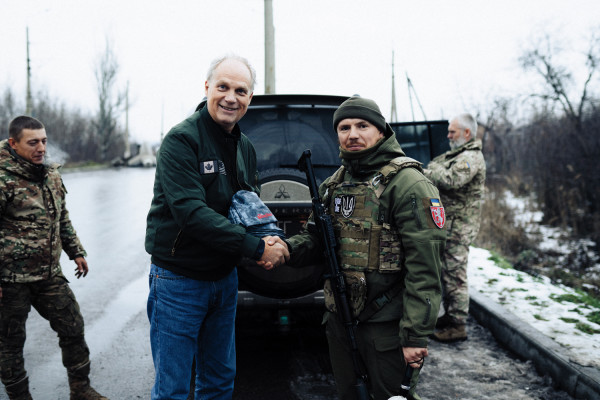
DAY 1
I departed Toronto on LOT Polish airlines on Nov. 20, arriving in Warsaw, Poland (WAW) on Nov. 21, where I changed planes for Rzeszow (RZE), the closest Polish city to the Ukrainian border served by LOT. The total flight time was just under 12 hours.
Landing at RZE is a wake-up call to the fact there is a war going on nearby, because you can’t help but notice all of the batteries of U.S. Patriot missile launchers that surround the airport. The missiles protect one of the major airports where military aid from NATO member countries arrives before being put on trucks and driven to the border 100 kilometers away. After these trucks cross the border, they begin the long journey to the eastern region 1,300 kilometers away.
Clearly, the U.S. government wanted to protect this airport since it was a gateway to the supply chain of Ukraine in its time of greatest need.
There, I was picked up by Nazar, a Ukrainian driver who had driven from Lviv to collect me and make his return trip, dropping me at my hotel in Lviv at 10 p.m. The back roads that seemed to forever twist and turn through forests and villages as we headed to the border reminded me of The Great Escape starring Steve McQueen. All of a sudden, in a clearing up ahead, bright lights of the border crossing permeated the trees, and I thought to myself that I had to tell Jerry Bruckheimer about this. Since he is a subscriber, I actually am.
First, the Polish border guards took a quick look at both my Canadian and U.S. passports before ushering me through towards the Ukraine border guards. Although only a few meters separate the two outposts, it was like night and day as one country was in peacetime while the other was visibly in wartime.
Imagine the biggest, toughest and most serious men who you have ever come across in your life, and they are still not equivalent to these warriors. There is an invasion of their homeland ongoing, and these guys mean business. This is as serious as life and death gets, yet they were professional in the way they questioned me. After the search of my vehicle was completed, the gate was lifted and my passports were handed back to me. The biggest guy, who towered over my 6-foot-2 frame, looked straight into my eyes and said, “Thanks for your help,” and winked.
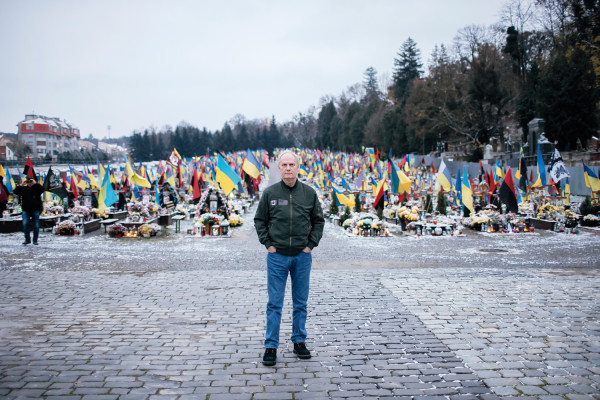
I crossed the Poland border into Ukraine on Nov. 21 at 7:30 p.m. at the Budomezh-Hrushiv border crossing and headed straight for the Lviv City Center. As I stepped out of the car onto the cobblestone streets that have been there for centuries, I felt the presence of my grandmother, who walked upon these same cobblestones that I now walk upon, more than 100 years later.
Lviv is the largest city in western Ukraine, and it was officially founded in 1256 by King Daniel of Galicia and was named in honor of his son, Lev. To put that in perspective, Toronto was founded in 1793, so we are talking about a difference in age of over 500 years.
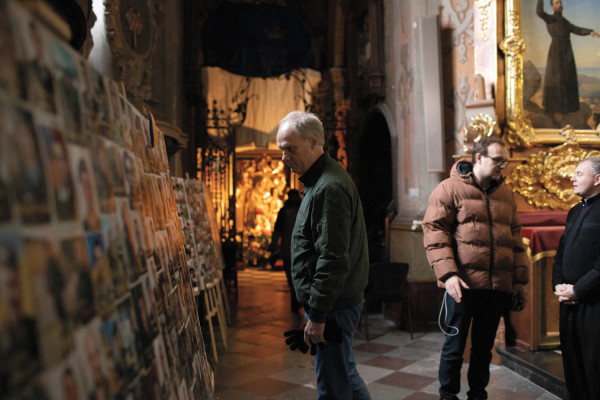
Lviv itself in 2022 had a population of just over 700,000, and, when including the suburbs, it reached 1.1 million people in total population. The one mystifying fact for this hockey guy is that it has a total of zero indoor ice rinks. How is it possible that the largest city in the western part of the second-largest country in Europe has no arena to play hockey in?
For all those hockey moms and dads out there who get up at 5 a.m. to drive their kids to the local hockey rink, let me just say that you are the envy of the parents in Lviv, who have to drive an hour outside of the city to find the only ice rink in all of western Ukraine. This is unacceptable, and it needs to change.
I visited the westernmost ice arena in Ukraine, which is in Novoyavorivsk, the home of the Lions. A nondescript building off a side road where, once you pass through the doors, that unique sound of a puck hitting the boards and skates on ice is music to my ears. I met the president of the club, Mykola Romanyuk, who had opened the building 14 years earlier. He was gracious enough to take me out on the ice to meet some of the boys and girls during practice, and I felt right at home. Now, I need to see more of these. '

DAY 2
Unbroken, headquartered in Lviv, is an unfortunate but necessary program that serves the needs of the wounded warriors from the effects of Russia’s invasion and occupation of Ukraine. It is housed in the largest general hospital in western Ukraine, which has undergone major renovations and conversions to serve the ever-increasing physical- and mental-healthcare needs of Ukraine’s heroes.
I was given a tour by Maryana Svirchuk, the CEO, and was introduced to many of Ukraine’s finest from both the battlefields and from their health-care system, and I am a changed and more grateful person for doing so. Men and women who have lost limbs, some of them their vision, and all of them their innocence – all stolen from them by war – are in the Unbroken program.
I spoke with several of their physicians who are responsible for the amputations and surgeries, as well as with Dr. Oleh Berezyuk, head of psychological direction and psychosocial rehabilitation who oversees all of the mental-health issues, all of which are too numerous and complicated to mention here. What is important for me to convey to you here is that the damage done to the bodies and the minds of these brave young men and women heroes of Ukraine is overwhelming.
The vast majority of them prior to Feb. 24, 2022, were just citizens living their lives as we do in Canada and the U.S. every day before they were called to defend their country. I spoke with men and women soldiers who before the war were athletes, administrators and artists, just to name a few occupations. Now that they are people with amputations and heroes of Ukraine, the dedicated staff are working around the clock to return all of them to society. (unbroken.org.ua)
Day 3
I met with Lviv’s mayor, Andriy Sadovyi, in his office after my visit to the Unbroken hospital the day before. He had flown back from Winnipeg just so that he could meet with me while I was in Lviv. The mayor is a very popular official, having served since 2006 in his position overseeing municipal affairs for this historic town.
He explained to me that the influx of wounded warriors who have been coming from the eastern front has been overwhelming for his westernmost city, however the entire community has embraced their heroes and it is his and their first priority every day to get them what they need to get them back assimilated into society.
The meeting with the mayor included Georgii Zubko, the president of the Ukraine Ice Hockey Federation, who himself currently serves in the military and served on the front lines at the beginning of the invasion. Zubko, like most Ukrainian men between 25 and 60, is on active service in the military and, in many cases, serves both in the military and in a civilian capacity.
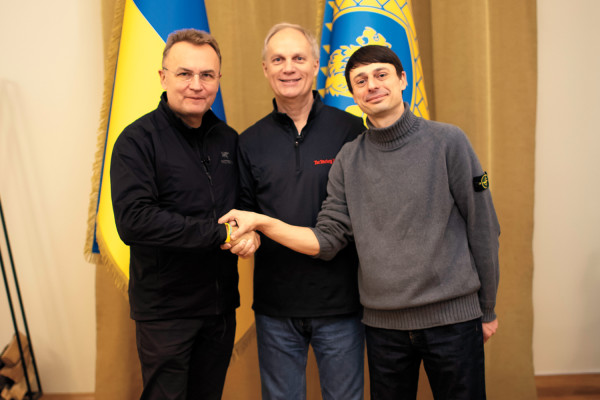
Together with many other officials in Ukraine and with the assistance of many other organizations from around the world, they have launched a program that both assists in the physical rehabilitation while improving the mental health of their wounded warriors. As part of the bigger program, they have decided that they need to build a hockey arena on the hospital grounds as part of their rehabilitation strategy, using the game of hockey and, in particular, sledge hockey as a cornerstone. They believe that as soon as they can get these wounded warriors back out on the ice, the better off they will be from both a physical and mental standpoint.
Sledge hockey is much more demanding than regular hockey, and it requires tremendous physical and mental toughness, which is why it is perfectly suited for these wounded warriors, as they are the definition of toughness.

The Unbroken program has begun planning for the construction of an arena designed from the ground up to serve the needs of the wounded warriors. I have been building, operating and owning ice rinks for more than 30 years, so I thought that by now, I had heard and seen just about everything, but I was wrong. I have never seen or even heard of the idea of building a community ice rink from the point of view of a sledge-hockey player before. All I have ever heard of before is how to make existing designs and future designs more accessible for those who play sledge hockey. This idea is a game-changer in more ways than one, and this is history-making when it comes to community ice rinks.
As mayor Sadovyi was showing the video presentation, my mind was racing on how great it would be for Lviv to become the European capital for sledge hockey. I also started a list in my head of friends of mine who love the game of hockey and who care deeply for wounded warriors and would naturally want to be a part of this revolutionary approach to the game.
The western regions of Ukraine are the safer areas as they do not come under attack by the Russians very often due to the extreme distance from the Russian border. This is a primary reason why Unbroken is located in the west and why so many citizens from the eastern region have relocated to get out of harm’s way. Clearly, there remains the risk that the Russians will target any community ice rinks in the future as they have in the past, but the Ukrainians are following the historic words of Winston Churchill: keep calm and carry on.
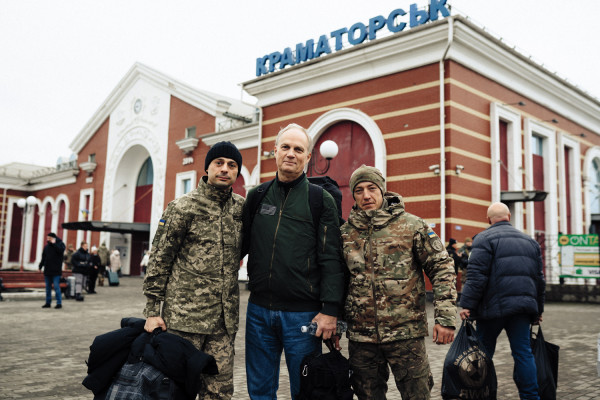
DAY 4
The Eastern Front
After meeting with Ukraine’s heroes, the wounded warriors, and then meeting with mayor Sadovyi and learning more about Unbroken, I went to the train station, where I boarded an overnight train at 11 p.m. on the night of Day 3 from Lviv to Kyiv, where I transferred to another train that took me to the eastern end of the line in Kramatorsk.
The total trip times on the two trains to go from Lviv to Kyiv and then on to Kramatorsk was 16 hours, covering 1,200 kilometers (750 miles) to cross pretty much the entire country.
As the two trains made their way from west to east, men and women in uniform would continually board the train at each stop along the way in big cities, small towns and villages. By the time we reached the last stop, there were no civilians left on the train other than me. The train was filled with hundreds of soldiers in full gear.
As I stepped off my train car, it was as though I was in a different world taken right out of a movie. I thought this is what it must have been like for the GIs in the Second World War who had left Canada and the U.S. to go and fight in Europe as they disembarked from troop trains. I just stood still and watched all of the hundred faces filled with determination walk by, some acknowledging me and smiling when they saw the Canadian and U.S. flags stitched on my army green jacket.
The platform was overflowing with the best of what Ukraine has, its freedom fighters willing to die for the freedom that they want to preserve for their families now and well into the future. These warriors were climbing into minivans, SUVs, cars and delivery trucks that we all see on the streets in Canada and the U.S. with one distinct difference: they were all painted a mud shade of green.
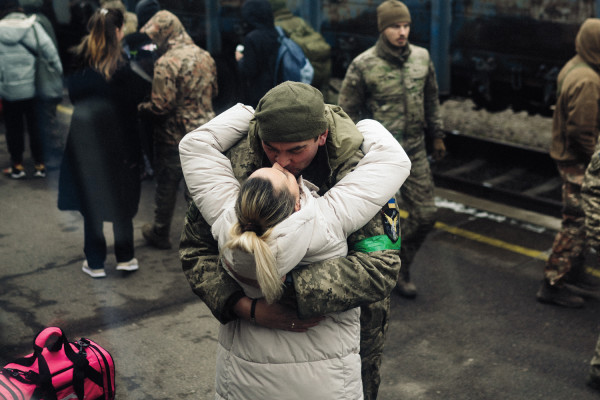
I made the trip from Lviv with Zubko, who I was about to learn was doing double duty at the time. As we were about an hour from the end of the line at Kramatorsk, he disappeared for a few minutes only to return in full uniform. It took me a couple of minutes to adjust to seeing him in this new light. I asked him if the name badge was his last name, Zubko, in Ukrainian script, because it was unrecognizable to me, and he responded that many soldiers use their given nicknames there in case of capture by the Russians. I asked him what the other soldiers call him, and he said that his given nickname was ‘Hockey.’
As the two of us walked along the platform amongst hundreds of other soldiers, all of us carrying our backpacks and most of them smoking cigarettes after a long journey, we were greeted by our military escort detail, Andrei and Yaroslav. They had served on the front lines with Zubko, and judging by the extended hugs they shared, they had spent some long days and nights together on the front lines in the trenches. Andrei was the driver, and Yaroslav rode shotgun while Zubko and I took up positions in the back seat of this converted SUV. The scene was wild, as dozens of these civilian vehicles that had been converted into troop carriers were loaded up with what was a sea of soldiers, all leaving the train station at the same time going off into every direction possible. It was organized chaos, yet it looked as if it was a choreographed routine performed daily.
When the noise of all the vehicle engines and voices from all the soldiers that were competing with each other for airspace had dissipated, the sound of artillery fire and explosions filled the air. I would like to say that it was like something that you would only see or hear in a movie, but that wouldn’t be true, because, here in Kramatorsk, in the Donetsk region, it is as real as it gets.
The roads are cratered from explosions, and there is debris as far as you can see, littering the roads and landscape. As we made our way down roads and through fields that are detours from roads that are no longer there, we headed towards Druzhkivka to visit Ukraine’s easternmost hockey arena in territory currently not occupied by the Russians. After a harrowing excursion through a war zone that I will never forget for the rest of my life, we finally arrived at a building where the only remaining feature that could resemble a community hockey rink was that it was rectangular in shape and had a high roof – what was left of it, that is.
I have walked into hundreds of ice rinks in my life, some of which were in pretty rough condition, but nothing could prepare me for what I saw and felt as the shivers ran up my spine. As I write this on my flight back to Toronto from Warsaw, a few days later, I still am having difficulty verbalizing what I saw. It is hard to describe what the inside of a bombed-out community hockey arena looks like, which is why many pictures were taken.

When looking at the pictures, one can see the charred remains of the players’ benches and penalty-box area, and what is left of the ceiling, walls and HVAC system. The visible crater in the cement at center ice, where the missile had hit, causing all of this destruction, is what brings it all home. Yes, home, as my home has always been in community ice rinks around the world. It is where I have always been the happiest and where, as a young boy to a grown man, the place where I have always felt the safest. Will the children of Ukraine now feel as safe in ice rinks as I have all my life? One hopes so.
We all departed the destroyed ice rink and boarded the militarized SUV heading for Kharkiv, eight hours away. All of us were silent for the better part of the first hour as we were digesting what we had all just experienced. As we headed northwest, the two-lane highway was filled with oncoming military transports ferrying tanks, fighting vehicles, fuel, water and supplies for hours and hours on end. Along the way, there were numerous checkpoints. For security reasons, I cannot say how many, where they were, how many soldiers were at the checkpoints or the passwords they used at each one for us to be allowed to continue on the road to Kharkiv.
What I can tell you is, once our vehicle was searched and cleared at each checkpoint, I would open my oversized military black backpack and hand out thermal camouflage toques with The Hockey News logo on them. All of these very young men who I met at the checkpoints (I didn’t see any women) went from stoneface to big smiles when I gave them the caps, and even a few told me that they still play hockey and have read a copy of The Hockey News.
One young man went so far as to tell me that it’s also known as ‘The Hockey Bible.’ Once again, I am reminded of the responsibility I carry on my back as the current steward of The Hockey News. Even at a time of war on the eastern front of Ukraine’s defense against Russia’s invasion, where a young man might pay the ultimate price, The Hockey News brought a smile to his face for a brief moment. A few of the soldiers gave us permission to take a picture, which we did.

Kharkiv to Kyiv
It took eight hours to get from the hockey arena in Druzhkivka, and it was the road of destruction as we went through the charred remains of Sloviansk and Izium on the way to Kharkiv. After a quick dinner consisting of a couple of pizzas and minestrone soup shared by all, Andrei and Yaroslav took me and Zubko to the Kharkiv train station for an 8:20 p.m. overnight train to Kyiv. Although neither of these two fine men spoke English, they communicated with me in very short and direct gestures along the way. They were not there to be tour guides or to become buddies on a road trip. They were sent to protect me from any peril that would come my way as I travelled to within earshot of the front lines on a media pass issued by the Ministry of Defense.
I had lobbied the Ukraine Ice Hockey Federation and the Ukraine Department of Defense to provide me with media credentials to be able to write this story, just as though my media company was on par with CNN, and they did. I had to sign releases and abide by rules to ensure the safety and security of Ukraine’s finest, and I did and will continue to honor my pledge of secrecy. It is because of the process to obtain media credentials that I became acutely aware that Andrei and Yaroslav were doing their duty to protect me by putting their lives on the line in doing so. For this, I am eternally grateful to them both, even though I don’t know if those are their real names at all.

DAY 5
Kyiv
As the train pulled into Kyiv at 3:10 a.m., air-raid sirens were sounding. The roads were empty due to the midnight-to-5-a.m. curfew, yet Zubko and I were allowed to be on the streets as he was in military mode and I was a media member with pre-approval. Our driver dropped me at my hotel before taking Zubko home. When asked by the front desk, I chose a high floor with a view of the river. They obliged but reminded me that, due to the sirens, I should proceed immediately to the bomb shelter, which I didn’t do.
Within minutes of entering my room, red and white tracer fire lit up the darkened city of Kyiv. Explosions were happening in rapid fire overhead and orange glows were seen on the horizon and reflected above to the overcast cloud ceiling. The Russians had launched the largest single attack on the city of Kyiv since the start of the invasion on Feb. 24, 2022, with a reported attack using 75 drones and missiles sent from multiple Russian bases, and I was right there right in the middle of the attack with a front-row window seat. Although Ukraine defenders warded off all but one of the drones, my requested interviews with president Volodymyr Zelenskyy and the mayor of Kyiv, Vitali Klitschko, now had no chance of happening later in the day.
After a couple of hours of sleep, I visited Bucha, Irpin and Borodianka to see some of the destruction caused by the invasion before going to the Kyiv Palace of Sports in the city center of Kyiv. The Ukrainian Hockey League championship game between Sokil and the Kyiv Capitals started at 6 p.m., and I was invited to drop the opening puck.
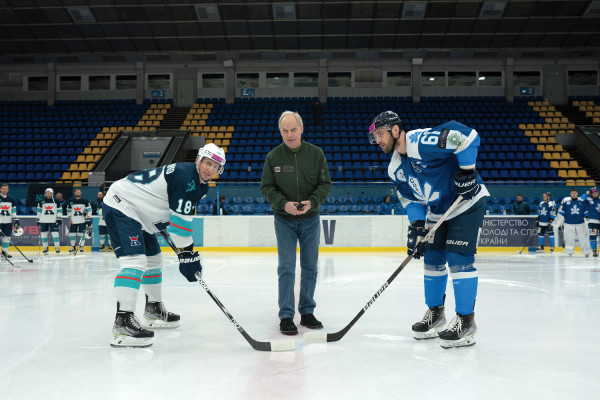
The government of Ukraine dispatched Matviy Bidnyi, the minister of sport, who is a hockey guy, to meet with me and do a Q&A as part of this story. In addition, I met up with Alex Godynyuk, a former Toronto, Calgary, Florida and Hartford NHL defenseman and current scout for the Vegas Golden Knights, who also volunteered to share his story with us. Understandably, the president and mayor of Kyiv were unavailable on this day when Kyiv suffered its greatest attack by the Russians. However, I got two other hockey guys in their place. Not a bad trade.
After the game, I went to the dressing room and visited the only American-born player on either team (there were no Canadians), Colin Whitt from Texas, who plays for the Kyiv Capitals. He’s just like every American or Canadian hockey player, politely calling me “sir” all the time, happy that he is playing hockey and passing off all the credit for his performance to his teammates. It’s stereotypical because it is true. I had to cut the conversation short as I went back out on the ice to drop the puck for the women’s championship game that followed the men’s.
The Kyiv Palace of Sports is a 6,500-seat arena in the city center, but since the invasion, the public is not allowed to gather in such numbers for a hockey game. Only friends and family of the players can attend, which tops out at 500 people. It is a clear sign that there is a war going on, and the possibility of incoming missiles from Russian territory is always on the minds of the citizens of Ukraine.
DAY 6
Homebound
The next morning, I woke up after interrupted sleep once again due to the sirens that went on sporadically during the night and headed to the train station in Kyiv for my 11 a.m. departure. For the next 11 hours, I retraced my steps on the train back to Lviv, then continued westward through Lviv and to the end of the line in Przemysl, Poland. From there, it was an hour-and-a-half by car to the RZE airport, where I checked into an airport-area hotel at 11 p.m. The next day, I reversed my inbound flights all the way back to Toronto.
As the day and scenery passed by and as I looked out over the rolling hills and vast lands of Ukraine, I thought about all of the boys and girls who once enjoyed playing the game we all love but today live in fear of going into buildings in case they are targeted.
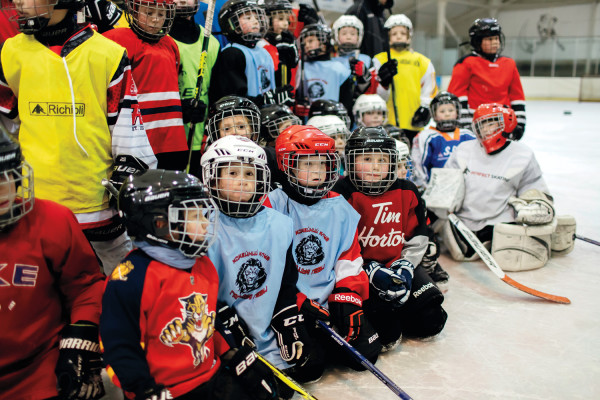
CONCLUSION
I spent six days in Ukraine going from the western border with Poland all the way to within 10 kilometers (six miles) of the front lines, where the Ukraine freedom fighters face off against the Russians, and then back again. I visited the westernmost and easternmost community hockey rinks as well as the biggest hockey arena in the center of the country in its capital, Kyiv.
I travelled much of the way with my new friend and president of the Ukraine Ice Hockey Federation, Georgii Zubko, and worked closely with his team led by Mariia Voitko. I learned of the pre-invasion plans to build dozens of ice rinks that were put on hold when Russia invaded Ukraine as funds were redirected for the defense of the country. I also learned that millions of family members have been displaced and the hockey programs have been decimated, just as the physical infrastructure of ice rinks have been.
I met and spoke with some of Ukraine’s heroes and was briefed on the overwhelming need to assimilate tens of thousands of those wounded warriors who have had amputations back into society using sledge hockey as an entry point. New ice rinks are a central part of the recovery process, both for the Unbroken program and all of Ukraine.
Hockey in Ukraine, just as life in Ukraine, has been hit by a devastating blow, which we can pinpoint the date back to Feb. 24, 2022, when Russia invaded Ukraine. Hockey and the entire country are fighting for their lives, and after spending six days in Ukraine, I believe that both hockey and life in Ukraine are reflective of each other in that they will be back stronger than before. They just need the help of hockey players and people from around the world who believe in their right to play hockey in freedom.

